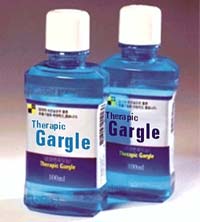Most mouthwashes contain abrasive agents, and using them in excessive amounts or improperly (such as swishing for too long or using them too frequently) can harm the delicate lining inside the mouth.
A Trendy Choice
 |
| Avoid using excessive amounts or improperly using mouthwash (Photo: octusa) |
The mouthwash product was first popularized by the “big player” L. (Thailand), who aggressively marketed this secondary oral hygiene product as a trendy item among young people, available in three colors: turquoise, shimmering gold, and mint green.
Following this, a series of brands from various countries flooded the Vietnamese market, including O. (UK), A S, L. (USA), T. (Germany), F. (Japan), and A. (South Korea), with bottles ranging from 250ml to 950ml, offered in various spicy and minty flavors, and advertised to be infused with peppermint, lemon, vanilla, floral essences, and even unscented options.
The price of these products is also quite high (for instance, L. USA 950ml costs around 175,000 VND per bottle; L. ranges from 42,000 to 95,000 VND per bottle depending on size; O. is priced at 32,000 VND for a 300ml bottle; and A S is about 132,000 VND for a 750ml bottle…).
Ms. Le Hoang Minh Anh, owner of the B36 grocery store at An Dong Market (District 5 – Ho Chi Minh City), revealed: “Mouthwash is currently selling quite well. The stock is being sent in significant quantities to various provinces.” Many customers using these products have reported feeling “uncomfortable” if they stop using them after trying.
The Truth
According to experts, the main ingredients in mouthwash include: Fluoride, sorbitol, ethanol, block copolymers, sodium, flavoring agents, and coloring agents…
The benefits listed on the packaging of most brands include disinfecting the mouth, preventing gum inflammation, reducing bacteria that cause bad breath and plaque buildup on teeth, preventing cavities, and promoting strong teeth while freshening breath…
However, Dr. Pham Xuan Sang, a lecturer at Ho Chi Minh City University of Medicine and Pharmacy, stated that the flavors in mouthwash primarily serve to please the palate; in reality, they do not whiten teeth.
Most mouthwashes contain abrasive agents, and using them in excessive amounts or improperly (such as swishing for too long or using them too frequently) can damage the delicate lining inside the mouth.
Additionally, some products contain “slightly high” levels of fluoride, and prolonged use can lead to dental fluorosis, which may cause black or yellow spots on teeth and even reduce the teeth’s resistance.
According to Dr. Pham Xuan Sang, mouthwash cannot whiten teeth but only cleans stains; thus, for those suffering from bad breath due to medical conditions, using mouthwash after meals is merely a temporary solution. Excessive use can lead to dry mouth due to the relatively high alcohol content in the products.
The best approach is to consult a dental specialist for specific treatment guidance.
Particularly, these products are highly unsuitable for children. If a small child accidentally swallows mouthwash while rinsing, it can cause digestive disturbances or affect the brain due to the significant fluoride content…




















































